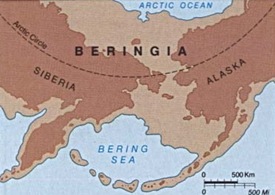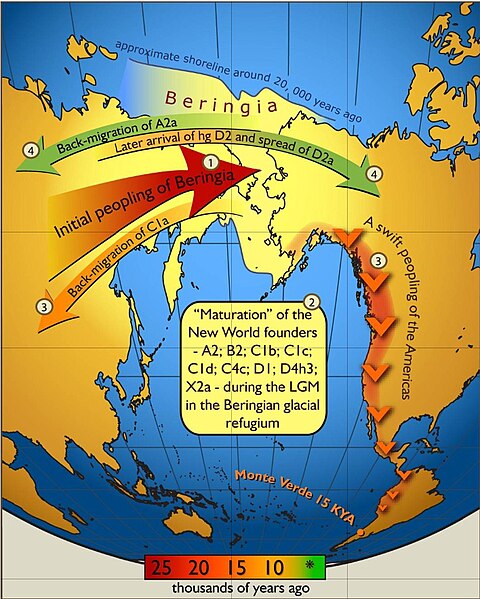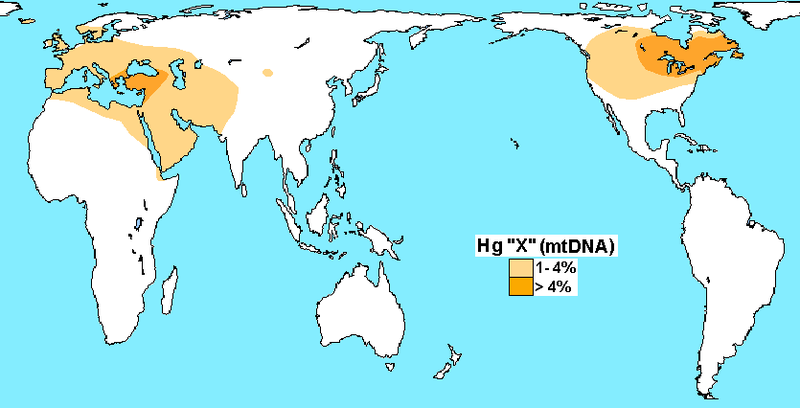The
theory that humans first came to the new world from Siberia via a land
bridge has long been the conventional wisdom. The closest land
connection from the old world to the new was between Siberia and Alaska.
During the ice age there was a land connection between the two
hemispheres since the sea level was lowered by glaciers as shown by the
graphic below. The shaded area on the graphic below shows the land above
water during the ice age.
This theory has been supported by DNA testing that indicates that most Native Americans are closely related to Asians by MtDNA that is inherited from mother to child, and by Y DNA that is inherited from father to son. The graphic below shows the theoretical movement of people from Asia to the western hemisphere by MtDNA.
The graphic below shows the distribution of the "Q" Y DNA passed from father to son. The majority of Native Americans are descended from "Q" which is also located in Siberia. The two continents are shown to be interconnected by the graphics below. It is obvious that this came from Asia
The theory of a Siberian only connection to the human settlement of the western hemisphere has been challenged by a number of individuals who believe that the Clovis stone age technology is similar to the Solutrean stone age technology found in Spain and France. "Across Atlantic Ice" by authors Dennis Stanford and Bruce Bradley presents an interesting theory that people could have traveled by boat along the ice pack that connected Europe and the new world during the ice age. They make their stone tools in a very similar manner and in way much different then those made in Asia. They would have used boating and hunting technologies similar to modern Inuit peoples, hinting seals and fishing and living on the ice.
"The majority of members of haplogroup R belong to its subgroup R1, defined by marker M173. R1 is very common throughoutEurope and western Eurasia in the form of its subclades R1a1a-M17 and R1b1b2-M269.[11][12]
R1 is the second most important haplogroup in Indigenous peoples of the Americas following haplogroup Q, and spreads specially in Algonquian peoples from United States and Canada.[9]"
It appears likely that human migration into the new world was more complex then the conventional wisdom of a connection only from Asia to America on the land bridge. New DNA research will likely improve our understanding, expecialy if DNA can be obtained from ancient American remains. But the last two graphics certainly support a possible connection via the Atlantic Ocean.
This theory has been supported by DNA testing that indicates that most Native Americans are closely related to Asians by MtDNA that is inherited from mother to child, and by Y DNA that is inherited from father to son. The graphic below shows the theoretical movement of people from Asia to the western hemisphere by MtDNA.
The graphic below shows the likely path
for the five major MtDNA haplogroups that pass from mother to child.
Haplogroups A, B, C, D follow a similar path from the old world to the
new. The only surprise here is that Haplogroup X has few links to Asia,
with more to the middle east and Europe.
The graphic below shows the distribution of the "Q" Y DNA passed from father to son. The majority of Native Americans are descended from "Q" which is also located in Siberia. The two continents are shown to be interconnected by the graphics below. It is obvious that this came from Asia
The theory of a Siberian only connection to the human settlement of the western hemisphere has been challenged by a number of individuals who believe that the Clovis stone age technology is similar to the Solutrean stone age technology found in Spain and France. "Across Atlantic Ice" by authors Dennis Stanford and Bruce Bradley presents an interesting theory that people could have traveled by boat along the ice pack that connected Europe and the new world during the ice age. They make their stone tools in a very similar manner and in way much different then those made in Asia. They would have used boating and hunting technologies similar to modern Inuit peoples, hinting seals and fishing and living on the ice.
The graphic below below shows the
location of MtDNA Haplogroup X passed from mother to child. Note the
concentrations in the northeastern part of North America and Europe,
West Asia, and North Africa. There is minimal connection to western Asia
and Siberia.
The graphic below shows concentrations
of the Male Y DNA R1. Note the concentrations in Europe and central Asia
and northeastern north America.
Main article: Haplogroup R1 (Y-DNA)
"The majority of members of haplogroup R belong to its subgroup R1, defined by marker M173. R1 is very common throughoutEurope and western Eurasia in the form of its subclades R1a1a-M17 and R1b1b2-M269.[11][12]
R1 is the second most important haplogroup in Indigenous peoples of the Americas following haplogroup Q, and spreads specially in Algonquian peoples from United States and Canada.[9]"
Some people believe that the R1 "Y"
Haplogroug and "X" MtDNA came across the land bridge from Siberia with
the other native American immigration. But the distance is great across
Asia, and the distribution in America makes a European connection more
logical.
DNA
testing can tell you what your "Y' DNA is from your paternal ancestor,
and what your MtDNA is from your maternal ancestor. Many people who
thought they had a Native American ancestor have been told that their
MtDNA is not Native American, and that they are descended from
Europeans.
A new book by geneticist Bryan Sykes, DNA USA,
indicates that many Americans in the northeast part of the United
States have little or no Native American ancestry, judging from their
MtDNA. And Professor Louis Gates has been advising African Americans
that the ancestors whom they thought were Native American actually were
European.
I think
that there must be more Native American DNA in the descendants of early
immigrants to the US. There would have been far more men immigrating
than women. They reproduced, and I am assured that females are
required.
I think
that the eastern half of the US must have been settled in ancient times
by people from Europe. This can be proved or disproved by DNA taken
from pre Columbian remains. If all the MtDNA is A, B, C, D, or X than
perhaps the Asian immigration only theory is correct. But I will bet
that we will find plenty of European DNA among ancient Native Americans.
It appears likely that human migration into the new world was more complex then the conventional wisdom of a connection only from Asia to America on the land bridge. New DNA research will likely improve our understanding, expecialy if DNA can be obtained from ancient American remains. But the last two graphics certainly support a possible connection via the Atlantic Ocean.
Further information at:
wearetheindians.blogspot.com


.jpg)



No comments:
Post a Comment